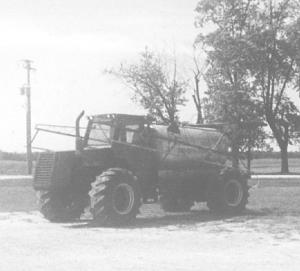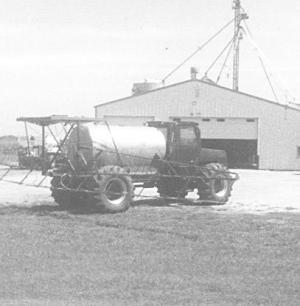1996 - Volume #20, Issue #2, Page #06
[ Sample Stories From This Issue | List of All Stories In This Issue | Print this story
| Read this issue]
SP Sprayer Built From Case 4-WD Tractor
 |
 |
"It's built with the strength and capacity of a Terra Gator but has narrower tires that'll fit between 30-in. rows with no problems," says Gieseke. "Works great for both preemergence and postemergence herbicide application."
Gieseke paid $8,000 for the used tractor. He cut the frame off behind the cab, then used angle iron and flat plate steel to lengthen the frame 12 ft. He also lengthened the driveshaft and steering cables, and reinforced the frame by mounting steel I-beams on each side. The tank, which he bought from a local fertilizer company, was originally designed to mount on a Terra Gator. It mounts on the same spring-loaded "V-block" mounting system used on the Terra Gator, which keeps the tank from shifting too much on hills and turns. He "squared off" the back side of the cab to allow the tank to mount as far forward as possible on the frame.
He used 2-in. sq. steel tubing to build the 3-section boom and mounted it behind the tank. The tractor's remote hydraulic outlets are used to hydraulically raise or lower the boom and to fold it against the sides of the tank. He made brackets for the tractor's remote hydraulic outlets and moved them alongside the frame. The sprayer pump mounts under the tank and is powered by a driveshaft that's belt-driven off the tractor engine.
"It's built tough. We can even use it to spray on chisel plowed ground," says Gieseke. "We built it because we wanted more capacity and because we were concerned about exposure to chemicals. How-ever, we didn't want to spend the money for a commercial self-propelled rig. We farm 3,800 acres and have to cover fields fast. We had been using saddle tanks and a soil conditioner to incorporate preemergence herbicide. However, my dad usually ran the soil conditioner and I didn't like him having to breathe chemicals all the time. Now he can spray without worrying about chemicals and without having to stop every 40 acres to refill the saddle tanks. We use two soil conditioners to incorporate preemergence herbicide behind the sprayer.
"Going 8 to 9 mph we can cover up to 300 acres per day, and at an application rate of 10 gal. per acre we can spray 160 acres without having to refill.
"My uncle George Freise did most of the work and my brother Brett and father Jerry helped. They sandblasted the tractor and painted it red. We spent less than $15,000 to build it. Many commercial sprayers with comparable capacity sell for $70,000 to $80,000 and aren't built as heavy. The tank's weight on back of the tractor provides a lot of traction. We no-till on hilly ground, but even in soft fields we've never been stuck. We've been in mud up to the front axle with-out getting stuck.
"We replaced the original tractor seat with an air ride seat out of a semi truck so it rides nice. It also has a Hiniker sprayer monitor. "We chose the Case tractor because it has a solid frame and didn't have articulated steering. As a result we didn't have to worry about building a hinge heavy enough to carry the tank's weight. Also, this tractor has four-wheel steering which allows us to turn sharp at the end of the field. We can set the steering so that both axles turn or just the front axle."
Gieseke used an old Surge water tank and an air compressor to build his own foam marker system for the sprayer. He made brackets to hold the tank which mounts on the boom frame. The air compressor mounts in front of the tractor and is belt-driven off the engine while the air tank mounts on the side of the frame. There's a one-way check valve at the bottom of the tank and an air pressure gauge in the cab. A switch in the cab that runs off an electric clutch is used to start the air compressor.
For more information, contact: FARM SHOW Followup, Ryan Gieseke, 2306 Deerpass Rd., Marengo, Ill. 60152 (ph 815 568-6340).

Click here to download page story appeared in.

Click here to read entire issue
To read the rest of this story, download this issue below or click here to register with your account number.




